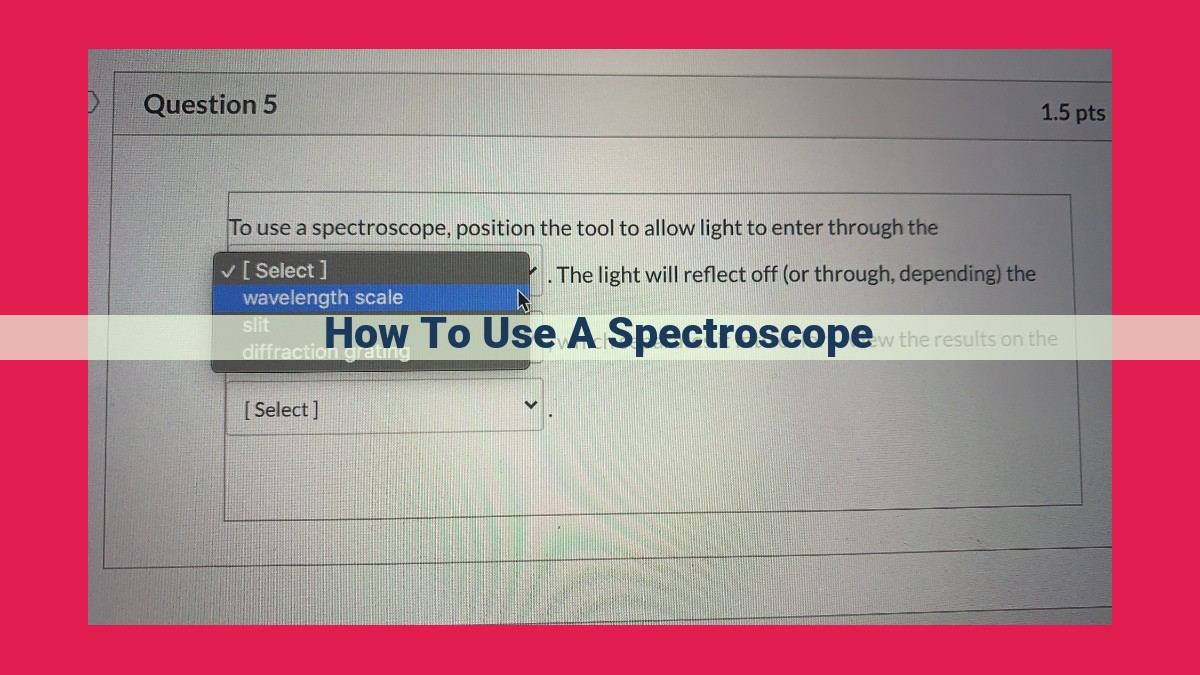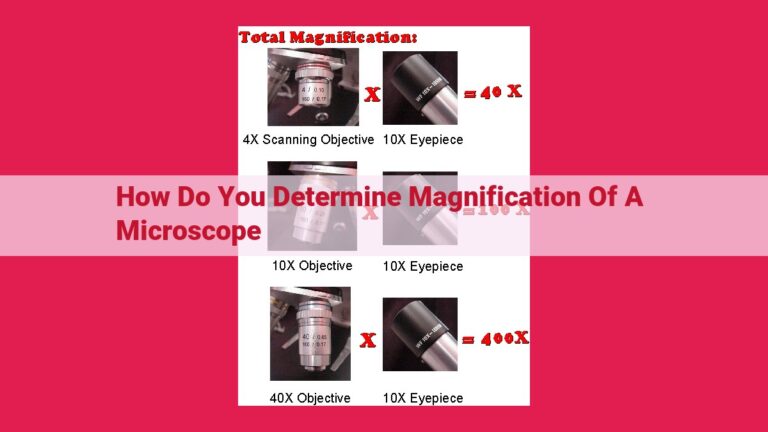Spectroscope Guide: Unlocking Chemical Secrets Through Light Analysis

To use a spectroscope, first prepare your sample and calibrate the device. Then, align the slit with the light source and focus the collimator. Position the grating to disperse the light, producing a spectrum. Adjust the eyepiece to observe the spectrum. The spectral lines correspond to specific wavelengths of light emitted or absorbed by the sample. Analyze the pattern, intensity, and location of these lines to identify and study the chemical composition or physical properties of the sample.
Spectroscopes: Unraveling the Secrets of Light and Matter
In the realm of science, unraveling the complexities of light and its interaction with matter holds immense significance. The spectroscope, an indispensable tool in this quest, has empowered scientists and researchers to delve into the depths of the spectrum, revealing secrets that shape our understanding of the universe.
Embarking on Spectroscopic Explorations
Spectroscopy stands as a branch of science that investigates the relationship between light and matter. It analyzes the spectrum of light emitted or absorbed by substances, revealing valuable insights into their composition and properties. From the shimmering colors of distant stars to the intricate molecular makeup of organic compounds, spectroscopy serves as a versatile tool for exploration.
Prism’s Play: Unraveling the Spectrum
At the heart of a spectroscope lies the prism, a captivating optical element that performs the remarkable task of dispersing light into its constituent wavelengths. As light traverses the prism’s crystal structure, its various wavelengths undergo differential refraction, causing them to separate into a kaleidoscope of colors. This fundamental principle forms the cornerstone of spectral analysis.
Components in Harmony: Unlocking Spectral Insights
To embark on spectroscopic endeavors, a spectroscope relies on a symphony of components. The collimator ensures that light entering the instrument is parallel, facilitating precise measurements. The grating, a key element, further disperses light, amplifying the spectral resolution. The eyepiece serves as a viewing portal, and the slit controls the amount of light entering the system, influencing both the resolution and sensitivity of the analysis.
Together, these components orchestrate a detailed exploration of the spectrum, akin to detectives unraveling the intricate pattern of clues.
Unveiling the Secrets of Light: Understanding Spectroscopes
Exploring the Working Principles of a Spectroscope
To truly comprehend the wonders of a spectroscope, let’s delve into the fascinating principles that govern its operation. Spectroscopy, the study of light and its interactions with matter, provides us with invaluable insights into the composition and properties of substances.
At the heart of a spectroscope lies the concept of dispersion, a phenomenon where light of different wavelengths (colors) is refracted at varying angles. This dispersion occurs when light passes through a prism, a specially shaped piece of glass or other transparent material. As the light enters the prism, its constituent wavelengths are bent differently, creating a spectrum of colors.
Another key principle is diffraction, the spreading out of light as it passes through a narrow slit. The slit is a crucial component of a spectroscope, as it allows only a narrow beam of light to enter the prism. This results in a collimated beam, or a beam of parallel rays of light.
The collimated beam of light then passes through the prism, where dispersion takes place. The different wavelengths of light are separated and focused on a screen or into an eyepiece, creating a visible spectrum. This spectrum is a rainbow-like array of colors, with each wavelength corresponding to a specific energy level of the light.
By analyzing the pattern and wavelengths of light in the spectrum, scientists can determine the chemical composition of a sample. Each element and molecule has a unique spectroscopic signature, making spectroscopes indispensable tools in fields such as astrophysics, chemistry, environmental monitoring, and medical diagnostics.
Unveiling the Components of a Spectroscope
Stepping into the fascinating realm of spectroscopy, we encounter a masterful tool that unravels the secrets hidden within light. At the heart of this instrument lies a quartet of crucial components: the collimator, the grating, the eyepiece, and the slit. Their harmonious interplay enables us to decipher the spectral fingerprint of any substance.
1. The Collimator
Imagine a beam of light dancing haphazardly, like a swarm of unruly photons. The collimator, acting as a beacon of order, aligns these photons into a parallel beam. This disciplined formation ensures that each photon embarks on a uniform path, preparing them for the next stage of their journey.
2. The Grating
A grating, a marvel of precision engineering, stands as the centerpiece of a spectroscope. This intricate grid of closely spaced lines acts as a prism, dispersing the parallel beam of light into a breathtaking array of colors. Each wavelength, like a musical note, occupies its own distinct position on the spectrum, creating a vibrant symphony of light.
3. The Eyepiece
Through the lens of the eyepiece, the dispersed light reveals its secrets. This magnifying glass allows us to observe the spectrum, where the intensity of each wavelength is plotted against its position. By carefully analyzing this spectral pattern, we can deduce the elemental composition and molecular structure of our sample.
4. The Slit
The slit, a narrow aperture, serves as a gatekeeper for the light entering the spectroscope. By adjusting its width, we control the amount and quality of light that reaches the grating. A narrower slit produces a sharper spectrum, while a wider slit admits more light but sacrifices resolution.
With these components working in concert, the spectroscope empowers us to explore the enigmatic world of light and matter. From the celestial tapestry of stars to the hidden depths of chemicals, spectroscopes illuminate the secrets that shape our universe.
Navigating the World of Spectroscopes: A Comprehensive Guide to Using These Fascinating Instruments
Spectroscopes, marvels of scientific precision, unveil the secrets concealed within light, unlocking a spectrum of knowledge. Embark on a captivating journey as we explore the intricacies of using spectroscopes, unraveling the mysteries of the universe and harnessing their power for groundbreaking discoveries.
Preparing Your Sample: A Crucial Step
Before embarking on your spectroscopic adventure, meticulous sample preparation is essential. The nature of your sample dictates the specific preparation techniques required. Solid samples, for instance, may necessitate grinding or dissolution, while liquid and gas samples often demand filtration or dilution. By carefully preparing your sample, you lay the foundation for accurate and meaningful results.
Calibration: Establishing a Benchmark of Accuracy
Prior to delving into data analysis, calibrating your spectroscope is paramount. This involves using a calibration standard, a substance with known spectral characteristics, to align the instrument’s wavelength scale. Precise calibration ensures that your measurements are accurate and reliable, enabling you to confidently interpret the spectral data.
Interpreting the Spectra: Unveiling Hidden Truths
The heart of spectroscopy lies in the interpretation of the resulting spectra. Each spectral line, an indicator of a specific wavelength of light emitted or absorbed by the sample, holds a wealth of information. By analyzing the intensity, wavelength, and patterns exhibited by these lines, spectroscopists can identify the elements present, study their interactions, and unlock a treasure trove of insights.
Applications of Spectroscopes
Venturing into the realm of scientific exploration, spectroscopes have proven themselves indispensable tools across diverse disciplines. From unraveling cosmic mysteries to safeguarding our planet and advancing medical frontiers, their applications are as varied as the colors they reveal.
Unveiling the Cosmos: Astrophysics
Astronomers gaze up at the celestial tapestry, armed with spectroscopes, to decipher the secrets of distant stars and galaxies. These instruments dissect the light from celestial bodies, revealing their chemical compositions and velocities. By analyzing the wavelengths of absorbed or emitted light, scientists can determine the presence of elements like hydrogen, helium, and even heavier ones forged in stellar furnaces.
Chemistry: Unmasking Molecular Structures
In the realm of chemistry, spectroscopes are the detectives of molecular structures. They illuminate the interactions between atoms, identifying and quantifying the functional groups that define a molecule’s properties. By shining specific wavelengths of light upon a sample, spectroscopes can excite electrons and study their subsequent energy transitions. This dance of electrons provides a fingerprint that unveils the molecular blueprint of unknown substances, aiding drug discovery and material analysis.
Environmental Monitoring: Sentinels of Our Planet
Spectroscopes stand guard as protectors of our environment. They monitor air pollutants and detect the presence of harmful chemicals in water and soil. By measuring the absorption or emission spectrums of various molecules, scientists can identify and quantify environmental contaminants. This vigilance ensures the well-being of our planet and safeguards its ecosystems for generations to come.
Medical Diagnostics: Precision in Patient Care
In the domain of medicine, spectroscopes play a pivotal role in diagnosing and monitoring diseases. They analyze patient blood samples to detect abnormalities in hemoglobin and other components, shedding light on conditions like anemia and leukemia. Spectroscopes also find application in non-invasive techniques like near-infrared spectroscopy, providing insights into brain activity and metabolic processes.
Tips for Optimal Spectroscope Usage
To ensure accurate and reliable results from your spectroscopic analysis, it’s crucial to follow these best practices:
-
Selecting a High-Quality Spectroscope: Invest in a spectroscope that aligns with your intended applications. Consider factors such as spectral range, resolution, light throughput, and ease of use. Reputable manufacturers with a proven track record are often a wise choice.
-
Ensuring Accuracy: Calibrate your spectroscope regularly using known standards to ensure its accuracy. This step helps eliminate systematic errors and provides confidence in your measurements.
-
Minimizing External Light Interference: Conduct experiments in a well-lit room to optimize signal-to-noise ratio. Use blackout curtains or a dark box to shield the spectroscope from stray light sources that could interfere with your readings.
-
Sample Preparation: Prepare your samples carefully to avoid introducing contaminants or altering their spectral properties. Use high-quality solvents and ensure samples are at the appropriate concentration.
-
Maintaining Stability: Stabilize the temperature and humidity of your experiment. Temperature fluctuations can affect the alignment of optical components, leading to inaccurate readings.
-
Minimizing Stray Light: Stray light, caused by internal reflections or external light leakage, can contaminate your results. Use baffles and optical stops to block out unwanted light.
-
Choosing a Suitable Light Source: Select a light source that provides sufficient intensity and matches the spectral range of your experiment. A consistent and stable light source ensures reliable readings.
By following these tips, you can optimize the performance of your spectroscope and obtain accurate and reliable data for your spectroscopic analysis.




